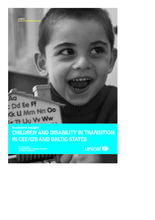When country reports for the 2002 UN Special Session on Children were reviewed, a startling pattern emerged in the CEE/CIS: reported rates of disability among children had doubled, tripled and more during the decade following the collapse of communism. UNICEF set out to investigate the causes of this dramatic increase. This report is a result of that inquiry. It is a first attempt to pull together and analyse data on children with disabilities on a region-wide basis. The portrait that has emerged is somewhat patchy, due largely to data limitations, but it is still compelling. For one, there is the simple fact – and attendant mental image – that at least 317,000 children with disabilities in the region live in residential institutions, often for life. For children with disabilities, this may be the defining legacy of the communist past: the purposeful institutionalization of huge numbers of children, often in large facilities segregated from community and cut off from family.
However, as this report explores, the reasons behind this practice are more complex than might first appear. Philosophically, communism held the belief that the state should act as a kind of caretaker to all citizens. In this context, persons with disabilities (including children) were officially recognized and registered by the state as ‘dependents’ and received supports such as pensions. At the same time, the state promulgated ‘defectology’ – a Soviet discipline that emphasized ‘special education’ as the best remedial treatment for children with disabilities. Whilethese strategies had some positive intentions and outcomes, their implementation – imbued as they were with deep stigma around persons with disabilities – resulted in many children with disabilities being shut away in institutions. It was not uncommon for infants and children with medium and severe disabilities to be placed in residential schools, only to ‘graduate’ to an adult institution for life.
Even children who stayed in their families had little chance of a normal life, given that streets and buildings were not accessible, community-based education and recreation were largely unavailable, and children with disabilities and their families were often shunned in public spaces or so shamed that they avoided venturing out in public. When transition began, children with disabilities were largely out of public sight. Their parents and families fared little better. As a result, there is now an opportunity – and, indeed, a compelling urgency – to improve the lives of children with disabilities and their families.
©UNICEF

